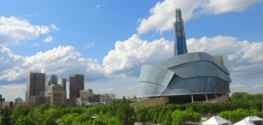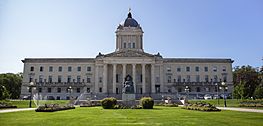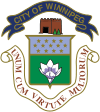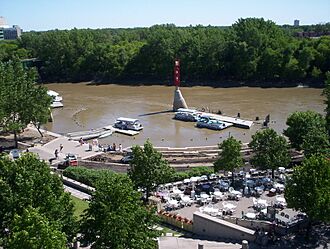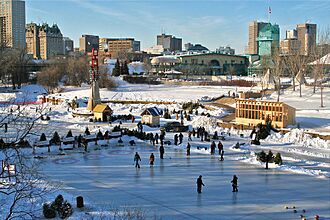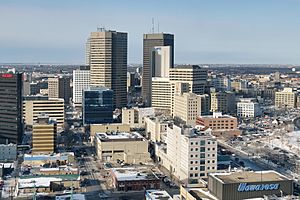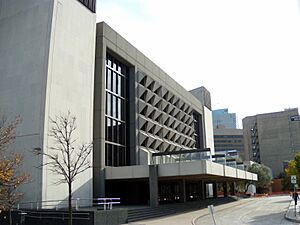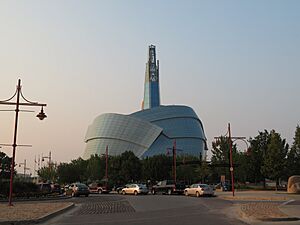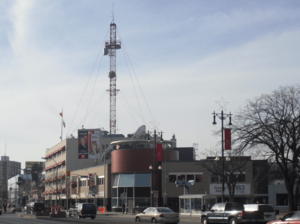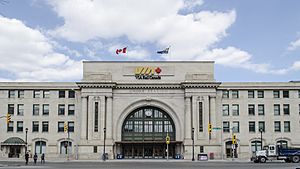Winnipeg facts for kids
Quick facts for kids
Winnipeg
|
|||||
|---|---|---|---|---|---|
|
City
|
|||||
| City of Winnipeg | |||||
|
Winnipeg panorama featuring the Canadian Museum for Human Rights
Saint Boniface Cathedral
|
|||||
|
|||||
| Nickname(s):
"Winterpeg"
|
|||||
| Motto(s):
Unum Cum Virtute Multorum
(One with the Strength of Many) |
|||||
| Country | Canada | ||||
| Province | Manitoba | ||||
| Region | Winnipeg Metropolitan Region | ||||
| Incorporated | 1873 | ||||
| Named for | Lake Winnipeg | ||||
| Area | |||||
| • Land | 461.78 km2 (178.29 sq mi) | ||||
| • Metro | 5,285.46 km2 (2,040.73 sq mi) | ||||
| Elevation | 239 m (784 ft) | ||||
| Population
(2021)
|
|||||
| • City | 749,607 (6th) | ||||
| • Density | 1,623/km2 (4,200/sq mi) | ||||
| • Urban | 758,515 (7th) | ||||
| • Metro | 834,678 (8th) | ||||
| Demonym(s) | Winnipegger | ||||
| Time zone | UTC−6 (CST) | ||||
| • Summer (DST) | UTC−5 (CDT) | ||||
| Area codes | 204, 431, 584 | ||||
| GDP (Winnipeg CMA) | CA$45.0 billion (2020) | ||||
| GDP per capita (Winnipeg CMA) | CA$50,510 (2021) | ||||
Winnipeg is the capital city of Manitoba, a province in Canada. It is the largest city in Manitoba. Winnipeg is located where the Red River and Assiniboine River meet. This spot is also near the middle of North America.
In 2021, about 749,607 people lived in Winnipeg. The larger metropolitan area had about 834,678 people. This makes Winnipeg Canada's sixth-largest city.
The city gets its name from nearby Lake Winnipeg. The name comes from the Cree words for "muddy water." Long ago, this area was a trading hub for Indigenous peoples. This was true even before Europeans arrived. It is the traditional land of the Anishinabe, Ininew, Oji-Cree, Dene, and Dakota peoples. It is also the birthplace of the Métis Nation.
French traders built the first fort here in 1738. It was called Fort Rouge. Later, in 1812, settlers from the Red River Colony started a community. This community officially became the City of Winnipeg in 1873.
Winnipeg is far from the ocean, so it has very different seasons. January usually has cold temperatures around -11°C. July is warm, with temperatures around 26°C.
Winnipeg is known as the "Gateway to the West." It is a major centre for railways and transportation. The city has a diverse economy. It also hosts many yearly festivals. These include the Festival du Voyageur and Folklorama. Winnipeg was the first Canadian city to host the Pan American Games in 1967. It is home to several professional sports teams. These include the Winnipeg Blue Bombers (football) and Winnipeg Jets (hockey).
Contents
- What Does the Name Winnipeg Mean?
- Winnipeg's Past: A Look Back
- Where is Winnipeg Located?
- Exploring Winnipeg's Neighbourhoods
- Who Lives in Winnipeg?
- Winnipeg's Economy
- Arts and Culture in Winnipeg
- Media in Winnipeg
- Learning in Winnipeg
- Getting Around Winnipeg
- Military Presence in Winnipeg
- Images for kids
- See also
What Does the Name Winnipeg Mean?
Winnipeg is named after Lake Winnipeg, which is about 65 kilometres north of the city. An English explorer named Henry Kelsey might have been the first European to see the lake in 1690. He used the Cree and Ojibwe name win-nipi. This means "murky water" or "muddy water."
A French-Canadian fur trader, La Vérendrye, called the lake Lac Gouinipique in the 1730s. The city officially became Winnipeg when it was incorporated in 1873.
Winnipeg's Past: A Look Back
Early Days of Winnipeg
Winnipeg is located at "the Forks." This is where the Assiniboine and Red River meet. This spot was a meeting place for First Nations for thousands of years. They used it for camping, hunting, fishing, and trading. Some estimates say people lived here as far back as 11,500 years ago.
In the early 1800s, First Nations people were farming along the Red River. The rivers were like highways, connecting northern peoples with those to the south. The Ojibwe people even made maps on birch bark to help fur traders.
Sieur de La Vérendrye built the first fur trading post here in 1738. It was called Fort Rouge. Later, the British Hudson's Bay Company took over. Many French traders married First Nations women. Their children were known as the Métis.
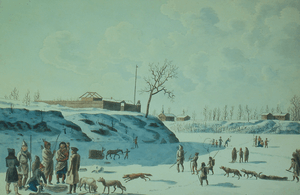
Lord Selkirk helped start the first permanent settlement, the Red River Colony, in the early 1800s. Two fur trading companies built forts nearby: Fort Gibraltar in 1809 and Fort Douglas in 1812. These companies fought over trade. The Métis and Selkirk's settlers even had a battle in 1816.
In 1821, the two companies joined together. Fort Gibraltar was renamed Fort Garry and became a main trading post. A flood destroyed the fort in 1826. It was rebuilt in 1835. Today, you can still see the front gate of the rebuilt fort in downtown Winnipeg.
Becoming a City
In 1869–70, Winnipeg was the site of the Red River Rebellion. This was a conflict between the Métis, led by Louis Riel, and new settlers. The Manitoba Act of 1870 made Manitoba the fifth province of Canada.
Treaty 1 was signed on August 3, 1871. This agreement covered the city and surrounding areas. On November 8, 1873, Winnipeg officially became a city. It grew quickly after the Canadian Pacific Railway arrived in 1881. The railway brought many new people.
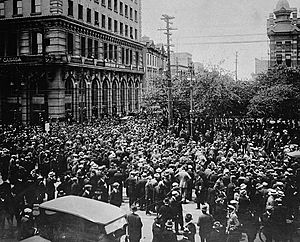
By 1911, Winnipeg was Canada's third-largest city. However, the opening of the Panama Canal in 1914 meant less trade went through Canada's railways. This caused Winnipeg to face economic challenges.
In May 1919, more than 30,000 workers went on strike. This was called the Winnipeg general strike. Workers wanted better conditions after World War I. The strike ended with some violence on June 21, 1919. Two strikers were killed. This day became known as Bloody Saturday.
The Manitoba Legislative Building opened in 1920. It has a famous bronze statue on its dome called the "Golden Boy." The Great Depression in the 1930s brought hard times to Winnipeg. Things improved after World War II started in 1939.
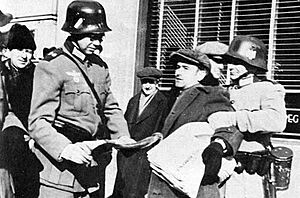
In 1942, Winnipeg even had a fake Nazi invasion. This was to help people understand the war and buy war bonds. After the war, there was a building boom. But the 1950 Red River flood caused a lot of damage. This led to the building of the Red River Floodway to protect the city from future floods.
In 1972, Winnipeg and its surrounding towns joined together to form one big city government. This was called "unicity." The city was also threatened by floods in 1997, 2009, and 2011.
Where is Winnipeg Located?
Winnipeg is at the bottom of the Red River Valley. This area is very flat. It is on the eastern edge of the Canadian Prairies in Western Canada. Winnipeg is known as the "Gateway to the West."
The city is close to many large lakes in the Canadian Shield, including Lake Winnipeg. Winnipeg has North America's largest old urban elm forest. The city covers an area of about 464 square kilometres.
Winnipeg has four main rivers: the Red, Assiniboine, La Salle, and Seine. In the past, the city had severe floods. The 1950 Red River flood caused huge damage. This led to the building of the Red River Floodway. This floodway helps protect the city from high water.
The flat land and clay soil in the Red River Valley can lead to many mosquitoes when it's wet.
Winnipeg's Weather
Winnipeg has a climate with warm, humid summers and long, very cold winters. This is called a humid continental climate. In July, the average temperature is about 19.7°C. In January, the average temperature is around -16.4°C. Sometimes, temperatures can drop below -40°C in winter.
Winnipeg gets a lot of sunshine, about 2,353 hours per year. This makes it the second-sunniest city in Canada. The total amount of rain and snow each year is about 521 millimetres. Thunderstorms are common in summer. Sometimes, they can even cause tornadoes.
The wind can make it feel much colder in winter. This is called wind chill. The wind chill has been as low as -57.1°C. On average, 12 days a year have a wind chill below -40°C.
The hottest temperature ever recorded in Winnipeg was 42.2°C on July 11, 1936.
Exploring Winnipeg's Neighbourhoods
Winnipeg has 236 official neighbourhoods. Downtown Winnipeg is the city's financial and economic heart. It is centered around Portage Avenue and Main Street. Over 72,000 people work downtown. Many students also attend universities and colleges there.
The Exchange District downtown is a National Historic Site. It has many old buildings from the early 1900s. Other important downtown areas include the Forks and Chinatown. Many downtown buildings are connected by the Winnipeg Walkway, an indoor pedestrian network.
Residential areas surround downtown. The city's largest park is Assiniboine Park. It has the Assiniboine Park Zoo and the Leo Mol Sculpture Garden. Other big parks are Kildonan Park and St. Vital Park.
Popular shopping areas include Polo Park and Kildonan Crossing. Fun places for culture and nightlife are the Exchange District, the Forks, and Osborne Village. Osborne Village is Winnipeg's most crowded neighbourhood.
Who Lives in Winnipeg?
| Population growth since 1871 | ||
|---|---|---|
| Year | Pop. | ±% |
| 1871 | 241 | — |
| 1881 | 7,995 | +3217.4% |
| 1891 | 26,529 | +231.8% |
| 1901 | 42,540 | +60.4% |
| 1911 | 136,035 | +219.8% |
| 1921 | 179,097 | +31.7% |
| 1931 | 218,785 | +22.2% |
| 1941 | 221,969 | +1.5% |
| 1951 | 235,710 | +6.2% |
| 1961 | 265,420 | +12.6% |
| 1971 | 246,246 | −7.2% |
| 1981 | 564,373 | +129.2% |
| 1991 | 616,790 | +9.3% |
| 2001 | 619,544 | +0.4% |
| 2011 | 663,617 | +7.1% |
| 2021 | 749,607 | +13.0% |
| The big population jump between 1971 and 1981 was because Winnipeg joined with nearby towns in 1972. | ||
In 2021, Winnipeg's population was 749,607 people. About 16.6% of residents were 14 years old or younger. The average age in Winnipeg was 40.3 years.
Winnipeg has the largest percentage of Indigenous people for any major Canadian city, at 12.4%. It also has the most Métis people.
Many immigrants live in Winnipeg. In 2021, about 27.3% of the population were immigrants. The largest groups came from the Philippines, India, and China. Winnipeg has the highest percentage of Filipino residents of any major Canadian city.
More than a hundred languages are spoken in Winnipeg. Most people (95%) speak English as their first language. About 2.8% speak French. Other common languages include Tagalog, Punjabi, and Mandarin. Some Indigenous languages like Ojibwe and Cree are also spoken.
In terms of religion, about 50.4% of Winnipeggers are Christian. About 36.4% have no religious affiliation.
Winnipeg's Economy
Winnipeg is an important economic centre. It has a varied economy. Many people work in health care, retail, manufacturing, and public administration. In 2019, there were about 450,500 jobs in the city.
Some of the biggest employers are government organizations. These include the Province of Manitoba and the University of Manitoba. Large private companies like Canada Life Assurance Company also employ many people.
In 2019, Winnipeg's unemployment rate was 5.3%. The average household income was $47,824.
The Royal Canadian Mint in Winnipeg makes all of Canada's coins. It also makes coins for many other countries.
Winnipeg has a lower cost of living compared to many other Canadian cities. In 2018, the average house price was $301,518.
Arts and Culture in Winnipeg
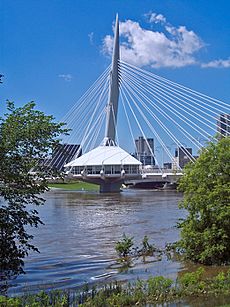
Winnipeg was named the Cultural Capital of Canada in 2010. The city has 26 National Historic Sites of Canada. The Forks is one of these sites. It attracts four million visitors each year. It has the Manitoba Theatre for Young People and the Manitoba Children's Museum. It also features a large skate park and the Canadian Museum for Human Rights. The Winnipeg Public Library has 20 branches across the city.
Did you know that Winnipeg the Bear inspired the name of Winnie-the-Pooh? A soldier bought the bear in Ontario and named it after Winnipeg.
Winnipeg has its own special foods. These include unique desserts like schmoo torte and wafer pie.
The Winnipeg Art Gallery is the oldest public art gallery in Western Canada. It has the world's largest collection of modern Inuit art.
Winnipeg's main performing arts venues are downtown. These include the Centennial Concert Hall and the Royal Manitoba Theatre Centre. The Royal Manitoba Theatre is Canada's oldest English-language theatre. Le Cercle Molière in St. Boniface is Canada's oldest French theatre company. Rainbow Stage is Canada's longest-running outdoor musical theatre.
Many Hollywood movies have been filmed in Winnipeg. These include Shall We Dance? and Capote. The Winnipeg Film Group has made many award-winning films.
The Winnipeg Symphony Orchestra is the city's largest and oldest professional music group. The Manitoba Opera is the province's only full-time opera company. Famous musicians from Winnipeg include Bachman–Turner Overdrive and Neil Young.
The Royal Winnipeg Ballet (RWB) is Canada's oldest ballet company. It is also the longest-running ballet company in North America. It was the first group to get a "royal" title from Queen Elizabeth II.
The Manitoba Museum is the city's largest museum. It shows the history of the city and province. It has a full-size replica of the ship Nonsuch. The Manitoba Children's Museum has twelve fun galleries. The Canadian Museum for Human Rights is Canada's only national museum dedicated to human rights.
The Royal Aviation Museum of Western Canada is near the airport. It has military jets, commercial planes, and even a "flying saucer" called the Avrocar. The Winnipeg Railway Museum has old trains, including the Countess of Dufferin, the first steam train in Western Canada.
Festivals in Winnipeg
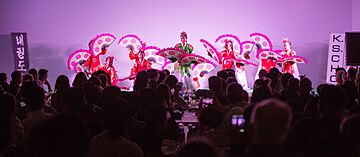
Winnipeg hosts many exciting festivals!
- Festival du Voyageur is Western Canada's largest winter festival. It celebrates early French explorers.
- Folklorama is the world's largest and longest-running cultural festival.
- The Jazz Winnipeg Festival and the Winnipeg Folk Festival celebrate music.
- The Winnipeg Fringe Theatre Festival is the second-largest alternative theatre festival in North America.
- The Winnipeg International Writers Festival brings writers to the city.
- Pride Winnipeg is an annual festival and parade for the LGBT community.
Sports in Winnipeg
Winnipeg loves sports!
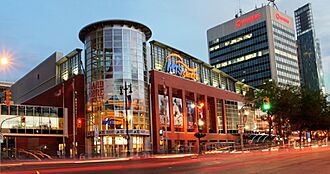
The Winnipeg Jets play in the National Hockey League (NHL). They have been in the city since 2011. The Jets play at Canada Life Centre. Before 2011, the original Winnipeg Jets played here until 1996.
Other hockey teams in Winnipeg's past include the Winnipeg Victorias, who won the Stanley Cup three times. The Winnipeg Falcons won a gold medal at the 1920 Olympics. The Manitoba Moose are another professional hockey team in the city.
The Winnipeg Blue Bombers play in the Canadian Football League. They have won the Grey Cup championship 12 times. They play at Princess Auto Stadium. This stadium is also home to the University of Manitoba Bisons football team.
The University of Manitoba Bisons and the University of Winnipeg Wesmen play in university-level sports. In soccer, Winnipeg has Valour FC and FC Manitoba.
Winnipeg has also had professional baseball teams. The Winnipeg Goldeyes have played since 1994. They play at Shaw Park.
Winnipeg was the first Canadian city to host the Pan American Games. It hosted them twice, in 1967 and 1999. The Pan Am Pool was built for the 1967 games. Winnipeg has also hosted the 2015 FIFA Women's World Cup and the 2017 Canada Summer Games.
| Club | Sport | League | Home Stadium | Started | Championships |
|---|---|---|---|---|---|
| Winnipeg Blue Bombers | Canadian football | CFL | Princess Auto Stadium | 1930 | 12 |
| Winnipeg Jets | Ice hockey | NHL | Canada Life Centre | 2011 | 0 |
| Valour FC | Soccer | CPL | Princess Auto Stadium | 2018 | 0 |
| Winnipeg Goldeyes | Baseball | American Association | Shaw Park | 1994 | 4 |
| Winnipeg Sea Bears | Basketball | CEBL | Canada Life Centre | 2022 | 0 |
| Manitoba Moose | Ice hockey | AHL | Canada Life Centre | 1996 | 0 |
Media in Winnipeg
Winnipeg has two daily newspapers: the Winnipeg Free Press and the Winnipeg Sun. There are also many weekly newspapers for different ethnic groups.
Radio broadcasting started in Winnipeg in 1922. Today, Winnipeg has 33 AM and FM radio stations. Two of these are in French. CBC Radio One and CBC Radio 2 broadcast local and national shows. NCI focuses on Indigenous programming.
Television broadcasting began in Winnipeg in 1954. Now, there are five English-language TV stations and one French-language station.
Learning in Winnipeg
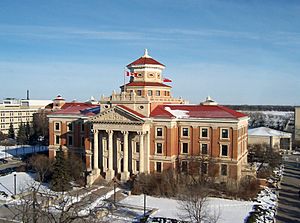
Winnipeg has seven school divisions for public schools. It also has several private schools.
The University of Manitoba is the largest university in the province. It was founded in 1877, making it Western Canada's first university. It has many undergraduate and graduate students. Université de Saint-Boniface is the city's French-language university. The University of Winnipeg also offers university programs. The Canadian Mennonite University is a private university.
Winnipeg also has three colleges: Red River College Polytechnic, Manitoba Institute of Trades and Technology, and Booth University College. These colleges offer different programs and training.
Getting Around Winnipeg
Transportation in Winnipeg
Winnipeg has had public transit since 1882. It started with horse-drawn streetcars. Now, Winnipeg Transit runs diesel buses.
Winnipeg is a major railway hub. Via Rail serves passengers at Union Station. Several companies handle freight rail. Winnipeg is the only major city between Vancouver and Thunder Bay with direct train connections to the United States.
Highways lead in all directions from Winnipeg. Manitoba Highway 75 connects Winnipeg to the United States. The Perimeter Highway circles the city. It allows travellers to bypass the city. The Trans-Canada Highway also runs through or around Winnipeg.
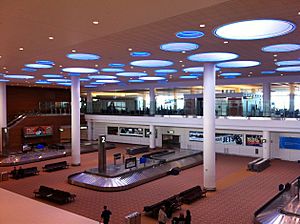
The Winnipeg James Armstrong Richardson International Airport finished a big upgrade in 2011. It has a new terminal and parking. The airport area is also home to CentrePort Canada, a special trade zone.
Several taxi companies serve Winnipeg. Ride-sharing services like Uber also operate here. Cycling is popular, and Winnipeg has many bike trails and lanes. People even bike year-round!
Hospitals and Health Care
Winnipeg has several major hospitals. These include Health Sciences Centre (which has a Children's Hospital), Saint Boniface General Hospital, and Grace Hospital.
The National Microbiology Laboratory in Winnipeg is a very important research facility. It is one of only a few labs in the world that can handle the most dangerous germs.
City Services
The city provides water and sewage services. Winnipeg gets its water from Shoal Lake through an aqueduct.
Electricity and natural gas are provided by Manitoba Hydro. This is a company owned by the province. It mainly uses hydroelectric power.
Winnipeg also hires private companies for services like garbage collection and snow removal.
Military Presence in Winnipeg
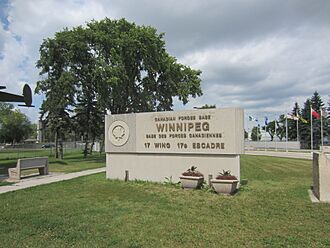
Canadian Forces Base Winnipeg is located at the airport. It is home to many flight support and training schools. It is also the headquarters for the 1 Canadian Air Division and the Canadian North American Aerospace Defense Command (NORAD) Region.
The base supports 113 military units across a large area. It also acts as a base for CF-18 Hornet fighter jets.
Two squadrons are based in Winnipeg. The 402 "City of Winnipeg" Squadron flies navigation training planes. The 435 "Chinthe" Transport and Rescue Squadron flies C-130 Hercules planes for airlift and search and rescue.
Winnipeg also has several units of the Canadian Army Primary Reserve. These include The Royal Winnipeg Rifles and The Queen's Own Cameron Highlanders of Canada. HMCS Chippawa is a Royal Canadian Navy reserve unit in Winnipeg.
Images for kids
See also
 In Spanish: Winnipeg para niños
In Spanish: Winnipeg para niños


